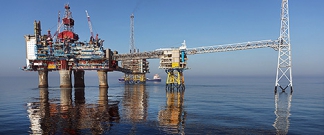Norway's Gassco Eyes 'CO₂ by Ship'
Norwegian state-owned Gassco said April 26 it has awarded contracts for the conceptual design of transporting carbon dioxide (CO₂) by ship.
Gassco is more commonly known as operator of more than 8,000 km network of subsea natural gas trunklines offshore Norway, owned by Gassled.
“We’re very pleased to award contracts to Larvik Shipping and Brevik Engineering covering conceptual studies for transporting CO₂ by ship,” said Gassco CEO Frode Leversund, saying theirs were the best tenders out of five submitted; he did not disclose contract value.
Gassco said that work done at the idea stage in 2015 and in a 2016 feasibility study showed that ship transfer would be appropriate in a start-up phase, given long distances but limited CO₂ volumes. Plans now envisage CO₂ being shipped by sea from capture facilities in eastern Norway to intermediate storage on the west coast, then piped to a subterranean store. If desirable, the vessels would be able to fetch the gas from other ports and the system can be scaled up with additional ships if the transport requirement increases.
The Smeaheia area of Norway’s North Sea, located east of the Troll field and about 50km from land, has been chosen as the final storage site.
The conceptual study is due to be completed this autumn, with the decision base for the whole full-scale project scheduled for autumn 2018, said Gassco, adding it would allow Norway’s parliament to take a possible investment decision in spring 2019.
Gassnova, the state-owned company for carbon capture and storage (CCS) projects, is responsible for incorporating work into a complete CCS chain together with studies of capture and storage facilities.
Last year Gassco was commissioned by the petroleum ministry to clarify the basis for ship transport of CO₂ from capture sites to the storage point. It recently awarded contracts for further studies of full-scale carbon capture to Oslo’s Klemetsrud incineration plant and industrial sites belonging to Yara and Norcem. Gassco said it is due to enter into a contract with the storage operator before the summer.

Sleipner offshore Norway has hosted a CCS project for the oil & gas industry for almost two decades (Photo credit: Statoil)
Norway has long pioneered the capture of CO₂ from oil and gas production, with commercial CCS schemes at Sleipner and Snohvit, and keen now to expand CCS into the harvesting of CO₂ from onshore manufacturing industry. The CCS at Sleipner, launched in 1996, was the world's first.
It's conceivable that, in the longer term, if the economics of CCS can be improved, some pipelines that in future are no longer required to transport natural gas could be reversed and converted to carry CO₂ from onshore industries offshore, thus extending the pipelines' economic lifetime.
US heralds large post-combustion CC project
The US Dept. of Energy (DOE) marked the opening earlier this year on schedule and on budget of Petra Nova which it describes as the world’s largest post-combustion carbon capture project. Designed to capture emissions from an NRG and JX Nippon jointly-owned 240 MWe coal-fired power plant near Houston, Texas, the system demonstrated a carbon capture rate of more than 90% during performance testing, said DOE recently.
Petra Nova is not a CCS project though, because it does not include definitive storage. DOE explained on April 13 that, at its current level of operation, Petra Nova will capture over 5,000 tons of carbon dioxide (CO2) per day -- for use in enhanced oil recovery (EOR) at the nearby West Ranch oilfield.
Mark Smedley



